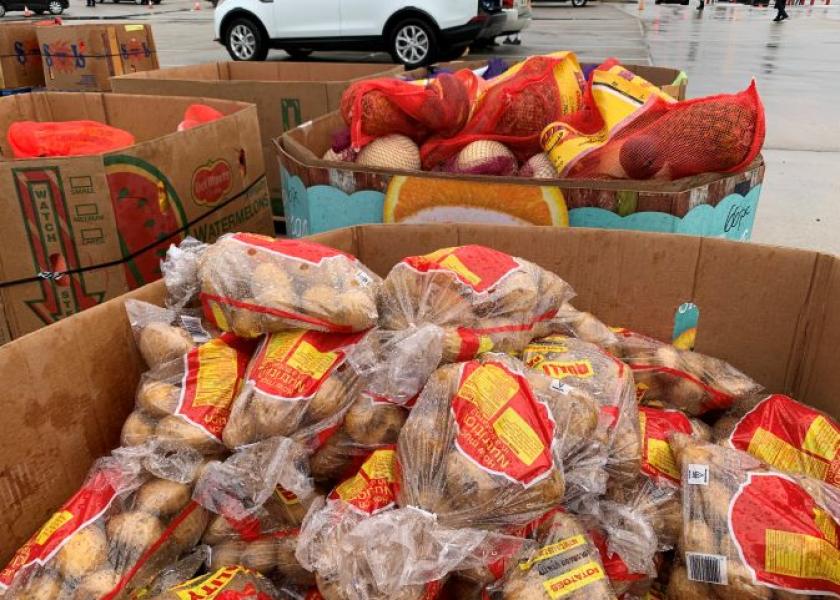A rocky road to stability as pandemic stretches on

The road to the new normal as the COVID-19 crisis continues is a rocky one for many in the fresh produce industry.
Growers for foodservice operators and distributors were waiting for U.S. Department of Agriculture coronavirus relief programs to kick in while nursing their businesses through an unprecedented period of uncertainty.
Growers are enforcing new rules to keep the virus from spreading in fields, greenhouses and packinghouses, and incurring higher costs in the process.
A Produce Marketing Association poll of consumers in mid-April showed that 44% of consumers said they were buying less produce because of financial concerns; 69% said they were concerned about the safety/cleanliness of fresh produce.
Even so, PMA said there had been no significant change in produce purchases of any form in mid-April compared with late March.
“Shoppers still more likely to say they are buying more as opposed to less of any form of produce,” the report said.
Supermarkets were finding near-normal conditions in Canada, said Mike Mauti, managing partner of the Execulytics consulting firm. While supermarket ads are fewer in number, retail conditions are similar to pre-pandemic, he said May 7.
Waiting for help
The USDA was expected to announce contract awards for the Farmers to Families Food Box program May 8.
Rules for the COVID-19 relief direct payment program for growers were being finalized, said Robert Guenther, senior vice president of public policy for the United Fresh Produce Association. The USDA sent its direct payment plan rules over to the Office of Management and Budget to review on May 5, Guenther said, but it is uncertain when details of the plan will be released by the USDA.
Separate from those programs, the USDA announced a plan in early May to buy $470 million in surplus food, including $105 million worth of produce. The agency said it was making the purchases to help growers cope with disrupted supply chains during the COVID-19 pandemic.
The USDA didn’t specify if the purchases for some of the commodities will be fresh. The purchases, which will happen July-September, include:
- Asparagus: $5 million;
- Pears: $5 million;
- Potatoes: $50 million
- Strawberries: $35 million; and
- Sweet potatoes: $10 million.
The USDA also plans to buy raisins, prunes, orange juice and tart cherries.
Before suggesting what further aid is needed, potato growers and the specialty crop industry is looking to see how effective the federal direct payment and food box programs will be, said Kam Quarles, CEO of the National Potato Council.
“I think we’ve got some ideas in the in the hopper in terms of what the overall next amounts are going to be, but some of that is going to be colored by how quickly is the reopening occurs,” he said.
Waiting
Relief programs like the Farmers to Families produce box purchases and other federal relief can’t come fast enough, said Seth Karm, CEO of Salad Savoy Corp.,Salinas, Calif., a shipper of colored cauliflower, kale and other items.
Before COVID-19, the company supplied white tablecloth foodservice operators. Now his business has shifted to retail and to processors.
“I would say we’ve scrambled like never before to find new avenues for our products,” he said May 7.
Salod Savoy has connected with processors and retailers over the past few weeks and hopes to carry that business while foodservice rebounds.
“We are probably 50% of our normal business right now,” he said.
Sales are slowly climbing every week and Karm expects foodservice business will pick up as states begin to loosen restrictions.
“Foodservice customers that have been absent for six weeks are beginning to reappear,” he said. “We’re seeing them as they’re coming in with smaller orders, trying to put things together with different people. I think that logistical piece of the puzzle has been a tough one.”
One complication has been rising truck rates.
Because trucks are having to come back empty (deadhead) to the West Coast from the East because of a lack of manufacturing activity, Karm said rates have been skyrocketing.
Karm was quoted $10,600 for a truck to Boston, when rates during a more typical year would be $7,000 to $7,500.
“Hopefully, (high rates) are not going to last too long,” he said.
California growers need a good summer, Karm said.
Vic Smith, CEO of the JV Smith Cos., said growers are taking steps to protect workers.
“We’re having to cut back the density in everything we do; housing, transportation, basically cut in half the density and then be very careful with all the procedures associated with day-to-day life,” he said.
Growers have had to disk fields of vegetables set to harvest in April, May and June because of diminished foodservice demand.
“We grow over 32,000 acres on an annual basis and the amount of acres that we disked from mid-March through this week has been frightening,” he said May 5. “I think we’re starting to level out; I think June will be a challenge in (the leafy greens) sector, but I think adjustments were definitely made in time for the first of July,”
Smith said the industry is expecting the market to stabilize beginning in July.
“Right now, there’s been big demand for the product considering we lost a huge sector of the business,” Smith said.
Labor worries
Guenther said that United Fresh is watching possible White House actions on guest worker labor that could hurt the industry. There are rumblings, Guenther said, that President Trump may expand an executive order on immigration to include H-2A workers. On April 21, Trump said his executive order would institute a 60-day pause that would apply only to people from abroad seeking green cards to become lawful permanent U.S. residents. If the executive order was expanded to include H-2A workers, Guenther said the fresh produce industry would suffer.
Such a move “would shut down new H-2 applications and guest workers from coming into the country, thus slowing down harvesting when the industry is getting into their peak harvest time,” Guenther said in an e-mail.
Michael Marsh. president and CEO of the National Council of Agricultural Employers, said agricultural employers continue to need support for the H-2A program from the federal government as “very few” of recently unemployed U.S. workers have applied for work in agriculture. Ag employers could also use additional personal protective equipment for their workers and employers would also benefit from a freeze on any new regulatory requirements being imposed.
Christopher Valadez, president of the Grower-Shipper Association of Central California, Salinas, said it partnered with the Salinas Valley Memorial Hospital to secure masks for farm employees.
“Over 100,000 have been secured and are being distributed to farming operations through the region, out of what will be a total of one million masks secured and distributed,” Valadez said May 7.
Salinas Valley (Monterey County) employees, in general, must wear a facial covering when near coworkers, he said.
“We are seeing workplaces observe practices that include both distancing and facial coverings,” he said, as well as training, education and sanitation practices.







